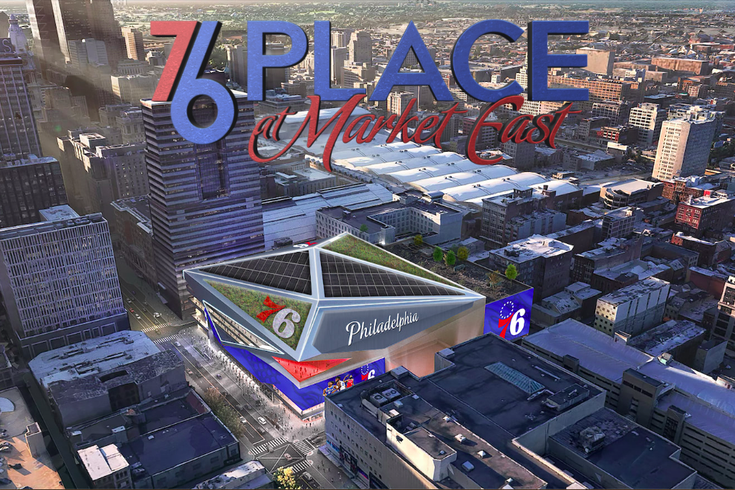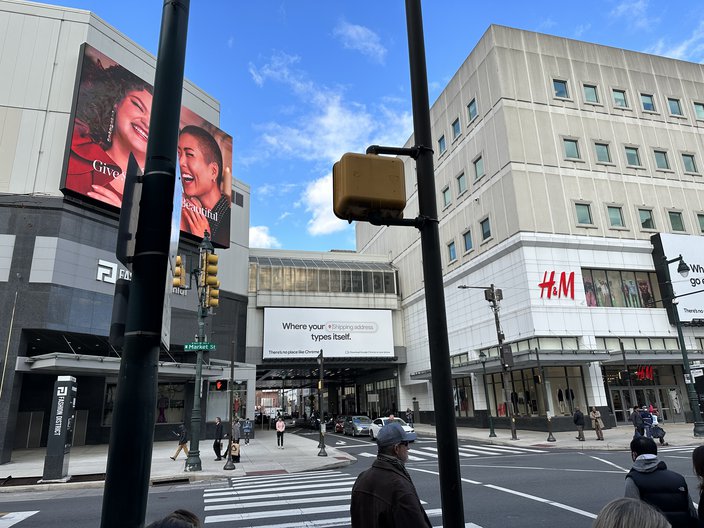
November 17, 2022
 Philadelphia 76ers/76place.com
Philadelphia 76ers/76place.com
An artist's rendering depicts the proposed Sixers arena at 10th and Market streets in Center City. The team's lease at the Wells Fargo Center will end in 2031.
Four months have passed since the Sixers announced their intention to build a basketball-first arena in the heart of Philadelphia, planting their flag after years of attempts to find a new home for the team. That bold vision for the arena took a backseat to the actual basketball over that time, and the Sixers have had plenty to sort out that did not involve a goal for 2031. But to get to that big, shiny light at the end of the tunnel, the Sixers have a lot to get done in the meantime.
David Adelman will be one of the big drivers of that work. After being named the Chairman of 76 Devcorp in July, Adelman took another massive step in his partnership this October, purchasing part of Michael Rubin's 10 percent stake in Harris Blitzer Sports and Entertainment. On Wednesday, Adelman and HBSE CEO Tad Brown met with a small group of reporters at the proposed site for the new arena, quite literally walking us through the vision for what will happen in the area.
As noted in their initial proposal, the new arena will set up shop between 11th and 10th Street off of Market Street. Walk that block to 10th, and you can see for yourself where the work starts and ends — the bridge between parts of the existing Fashion District is expected to remain in place, with the H&M at the corner of 10th and Market expected to be brought in to service an outdoor plaza for the area.
That bridge staying there is part of a theme of connectivity the Sixers reinforced on Wednesday. Roughly 1/3 or 1/2 of the block facing the Fashion District is unused, blacked-out property right now, far from the vision of vibrant area they envision with this plan. The hope is that they can tie together the surrounding pieces of this area by using the arena as a conduit. They want a backdoor connected to Reading Terminal Market, retail stores and restaurants attached to the arena that are open even when the Sixers aren't playing. The hope is to bring more foot traffic to the entire area, not just this arena.
And part of that starts with the biggest concern for the project from the public — transportation. Already, the Sixers are talking about big changes they anticipate will be made over the next near-decade, including the extension of Jefferson Station entrances and improvements to Jefferson's platforms.
This is all in service of a vision that will harken comparisons to other downtown arenas. If you walk up the steps or take the escalator from the stop at Jefferson, take a gander at the Dunkin Donuts in the corner right before the concourse crosses over to the mall. The tunnel to get to the court will be right about there, only steps away from the train. While Madison Square Garden's setup near Penn Station is a natural reference point, Brown noted Wednesday it probably shares most in common with TD Garden in Boston.
There's a related issue on the minds of many — parking. The immediate concern many people had in comparison to the South Philly complex was whether they'd even have the option to park a car nearby, with residents of the area obviously concerned for a very different reason, surplus parking pushing them out of their neighborhood spots. Adelman said Wednesday that when fans open up the app that owns their tickets, they'll find a geolocator that guides them to one of 29 parking garages with which they've made an arrangement.
"The goal is within a 10-minute walk, there are 29 garages, 9,000 spaces," Adelman said, "of which over 5,500 will be available every game night."
They are betting on a shift in habits. At present, the Sixers estimate about 20 percent of their fans take public transit, even though 50 percent of their regular attendees either live or work in Center City. One of the biggest challenges, Adelman admits, is trying to change the muscle memory of people who have been frequenting the sports complex in South Philly for most or all of their lives. Philadelphia is a city where tradition matters a lot, and even if it weren't, trying to overwrite 50 years' worth of habits and routines would be an undertaking itself. The Sixers are hoping to offset that through accessibility in the period before the arena opens, reinforcing how easy they think it will be to get there through things like virtual tours.
(An additional note related to public transport: the Sixers would not fully commit to being 100 percent carbon neutral when asked on Wednesday, but noted the goal is to have the smallest possible footprint they can. Their initial rendering highlighted the use of solar panels and a green roof, but Adelman noted there are further steps beyond that, like the use of more eco-friendly cement or practicing composting.)
There will be quirks that are either a feature or a bug depending on who you are. On game days, Filbert Street behind the arena will be closed to traffic between 10th and 11th, serving as a concourse on the back side of the arena. But the Sixers want this area to be open at all other times, and Adelman makes sure to point out the hard line where their vision ends, at the back of the current Greyhound Bus stop that will be moved.
For now, these are secondary concerns in comparison to actually getting this project off of the ground in the first place. There are a lot of stamps of approval to be made between now and next June, which is the goal date for the Sixers to officially have a project set.
The first hurdle is coming to an agreement on Philadelphia's community benefits agreement, which Adelman expressed optimism about on Wednesday. There are a number of different community groups the Sixers are in discussions with in the area. In the case of Washington Square West Civic Association, they're dealing with one central group. But nearby Chinatown, Adelman says, is unique in the number of different groups representing the area, each of whom brings a different set of thoughts or concerns to the table. Though they say the vast majority of groups are on board, Adelman admits they don't expect everyone to be on board, even if their goal is to get as much buy-in as possible.
"What can we do for the community that helps solidify Chinatown, but also can build it instead of where it sits right now? The merchants are concerned about crime, public safety, cleanliness, and we can help solve for that," Adelman said. "Affordable housing is a need they have pre-arena, they're worried about their community shrinking, and how do we do something there? We're developers, so we can do it, but there's also a bunch of local Chinatown developers that have been trying to do some affordable housing, and we can put in some capital to help that."
On the security and safety fronts, the Sixers are bringing in help to guide them on the best path forward. Maureen Rush — who spent 21 years as Penn's VP of Public Safety before retiring in 2021 — was along for our tour Wednesday and is lending her wisdom to the project. Many of the principles are fairly straightforward. For example, if you make a neighborhood feel safer with low-hanging fruit like consistent lighting, you drive more foot traffic. Increased foot traffic makes it harder to prey on individuals or small groups, and the public feels safer in numbers.
All told, the Sixers think that the community benefits agreement will end up being some blend of better safety and security, development, and marketing support for business. They're also planning to use one of HBSE's franchises as a blueprint for including surrounding businesses. Brown is overseeing a revitalization of the Prudential Center in Newark, where bringing more local businesses into the concession lineup was one of many goals. Adelman says they're committed to having local Chinatown businesses as part of the food options at the new arena beyond what they hope they can drive to the established locations in the neighborhood.
Assuming they reach an agreement with those groups, Councilman Mark Squilla would introduce an ordinance for their zoning at a city council meeting. As long as that gets approved (again, their goal is to have this squared away by next June), the wheels of the project would be in motion.
As for the fun parts of the new arena — the bells and whistles, the fan experience, and so forth — the Sixers are hesitant to say much about what will stand out in their new building. Part of this, they say, is because the value of building a brand-new arena is putting things in that are actually brand new. As a group, they've toured arenas all around the world in recent months, each offering something slightly different to guests and hosts alike. But at the speed tech moves, Brown and Adelman say the arena they want to build literally and figuratively doesn't exist yet.
Nine years out from the arrival of this as-of-now theoretical home, the Sixers are at the moment trying to get by with what they have. Adelman laments the fact that players often have to travel to the Camden facility after a game in order to receive further medical follow-up as a result of what they don't have at Wells Fargo Center. All the big sales points, from the privately-funded promise to the community goals, are critical as it pertains to the city and the approval process, which are much bigger than just the Sixers. But ultimately, this is a basketball team hoping to build a basketball arena.
"There haven't been any developers coming down here right now saying, that's where I want to be," Brown said Wednesday. "We think this is the best place for the arena, and we think it's going to transform this part of town, and really take us to hopefully the next level organizationally, to be able to control what we feel is going to be a great next 30, 40 years."
"It's time to kind of control our own destiny."
Follow Kyle on Twitter: @KyleNeubeck
Like us on Facebook: PhillyVoice Sports
